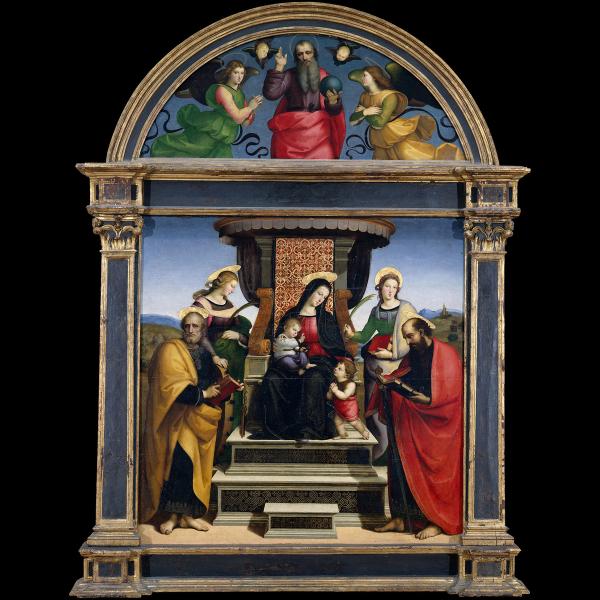Madonna and Child Enthroned with Saints
Artwork Details
- Title:Madonna and Child Enthroned with Saints
- Artist:Raphael (Raffaello Sanzio or Santi) (Italian, Urbino 1483–1520 Rome)
- Date:ca. 1504
- Medium:Oil and gold on wood
- Dimensions:Main panel, overall 67 7/8 x 67 7/8 in. (172.4 x 172.4 cm), painted surface 66 3/4 x 66 1/2 in. (169.5 x 168.9 cm); lunette, overall 29 1/2 x 70 7/8 in. (74.9 x 180 cm), painted surface 25 1/2 x 67 1/2 in. (64.8 x 171.5 cm)
- Classification:Paintings
- Credit Line:Gift of J. Pierpont Morgan, 1916
- Object Number:16.30ab
- Curatorial Department: European Paintings
Audio

5075. Madonna and Child Enthroned with Saints
Raphael, 1504
PRIYANCA RAO: This painting really reminds me of my childhood.
My name is Priyanca Rao. I’m a New York City photographer.
So when I was growing up, my parents took me to the temple on weekends and there would be beautiful paintings of gods and stories. And I would sit down and ask my dad to tell me stories about what was happening in these paintings.
NARRATOR: Rao grew up in India seeing Hindu, not Christian iconography. But this painting sparks commonalities in her imagination.
PRIYANCA RAO: There would be different clues in the paintings. Like symbols that depict who they are, their strengths, what they stand for. And just looking at this painting, like the halos around the heads, the hand gestures, all of those little clues reminds me of those nostalgic memories.
NARRATOR: Christians encountering this altarpiece during Raphael’s time would have recognized their own visual cues to interpret this scene. For example, why does the Madonna or Virgin Mary sit on a throne? Curator Stephan Wolohojian.
STEPHAN WOLOHOJIAN: She's queen of heaven. And here it's not necessarily a seat of power. It's truly a throne of wisdom.
NARRATOR: Beside Mary, two female figures hold palms, symbolizing their status as martyr saints: Lucy and Catherine. They would have had particular resonance with those who commissioned this painting: a community of religious women.
STEPHAN WOLOHOJIAN: The commission specified creating an altarpiece for what they called the inner church, or the area reserved for the nuns.
NARRATOR: Even for the time, aspects of this scene were conservative - for example, the Christ Child is clothed instead of naked. Some scholars think the nuns could have requested this, but perhaps not....
STEPHAN WOLOHOJIAN: We just assume that the convent was a more static and a more traditional and a less progressive space. But it was a rather freeing space, they were actually very progressive.
NARRATOR: Either way, it’s a reminder that even artists as famous as Raphael were usually working on commission. Then as now, works of art reflect the artist’s point of view…but also what the client wants.
PRIYANCA RAO: At the end of the day, it has to be usable, and it has to tick off all the boxes that your client is looking for, which is quite hilarious, because this is such a long time ago, and it applied to them too.
More Artwork
Research Resources
The Met provides unparalleled resources for research and welcomes an international community of students and scholars. The Met's Open Access API is where creators and researchers can connect to the The Met collection. Open Access data and public domain images are available for unrestricted commercial and noncommercial use without permission or fee.
To request images under copyright and other restrictions, please use this Image Request form.
Feedback
We continue to research and examine historical and cultural context for objects in The Met collection. If you have comments or questions about this object record, please contact us using the form below. The Museum looks forward to receiving your comments.
